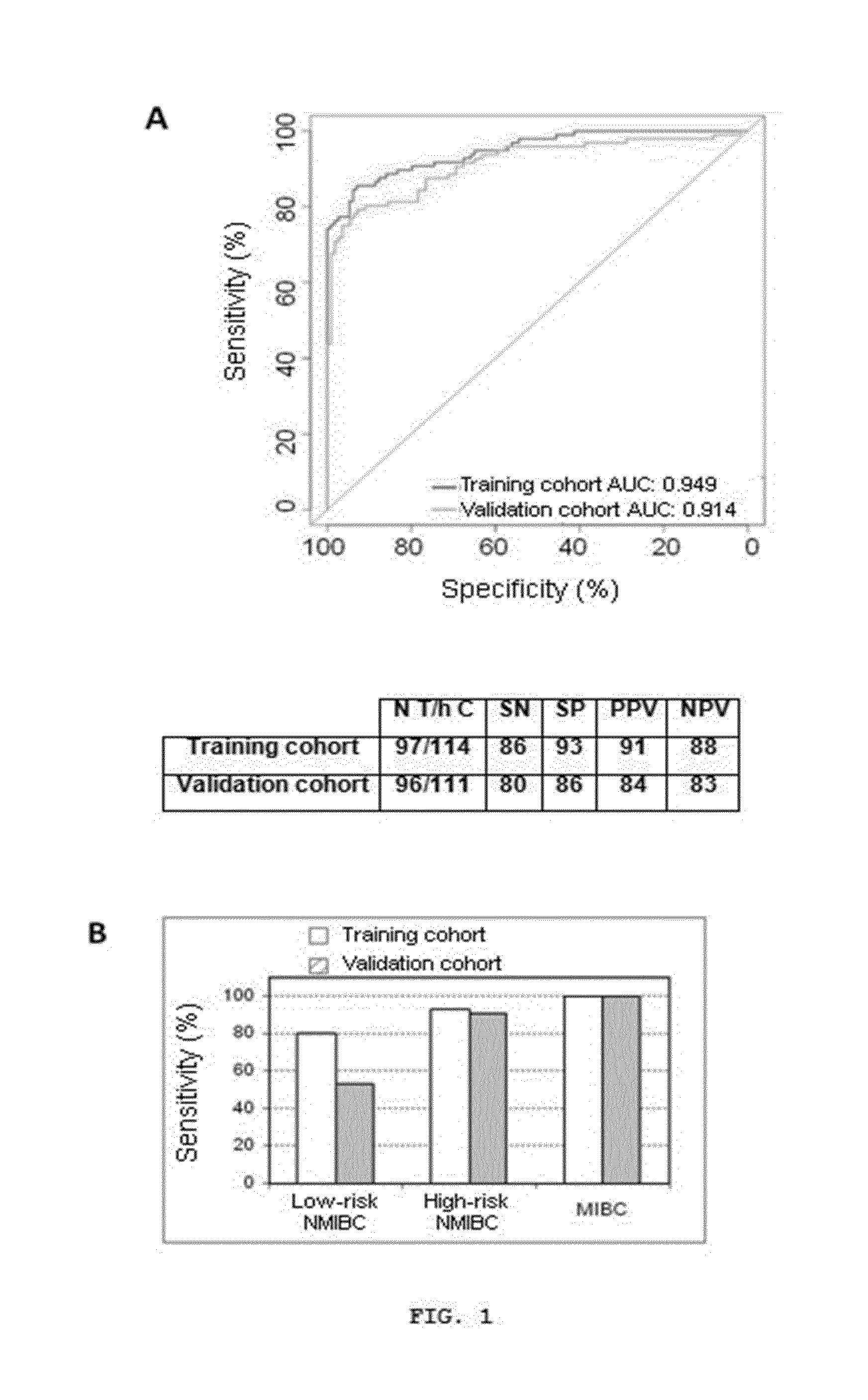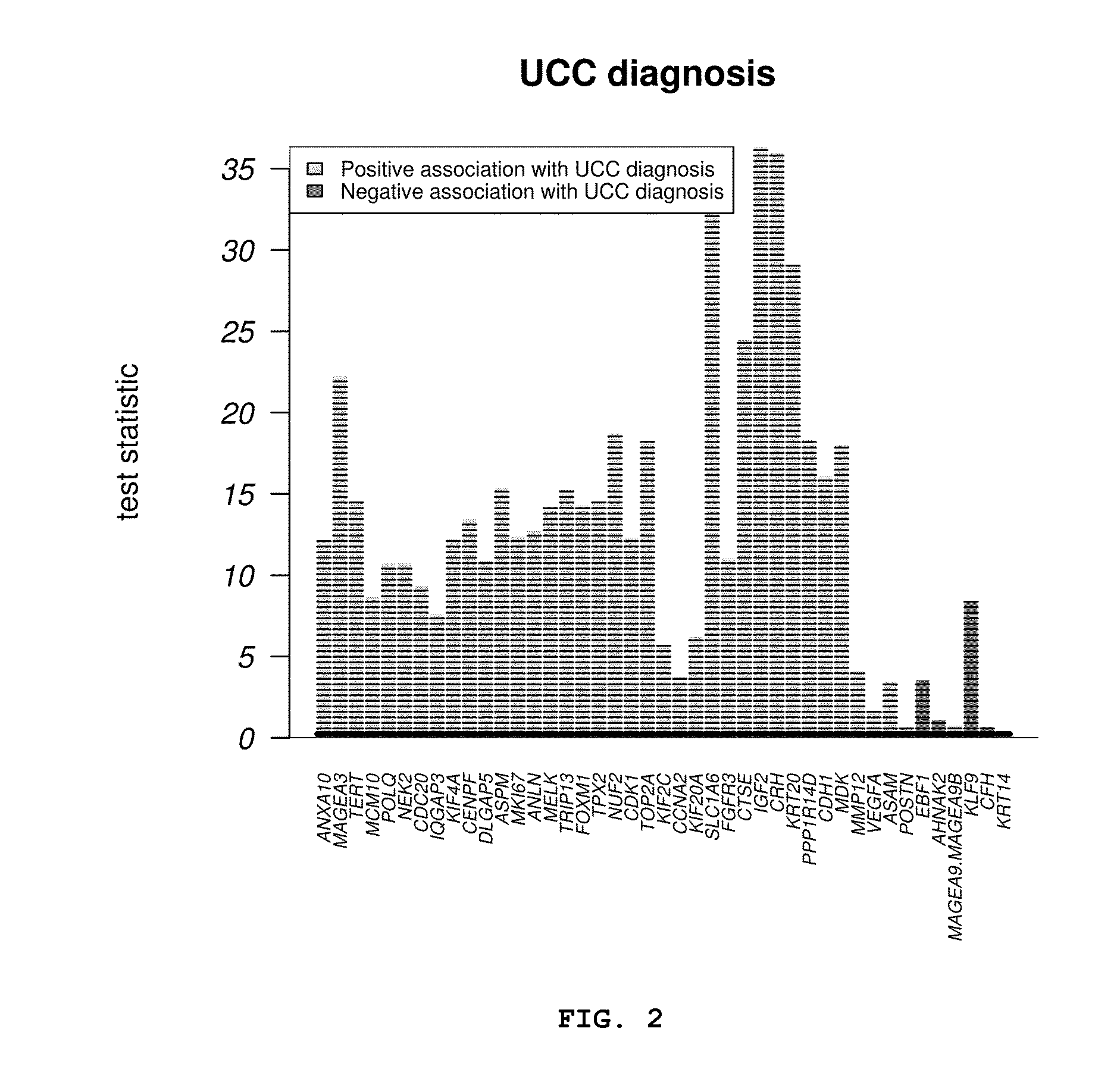Non-invasive diagnostic method for diagnosing bladder cancer
a non-invasive and diagnostic method technology, applied in the health sector, can solve the problems of brevity of pre-, invasive and patient-related techniques, and achieve the effects of preventing recurrence, superior to standard chemotherapy, and preventing recurren
- Summary
- Abstract
- Description
- Claims
- Application Information
AI Technical Summary
Benefits of technology
Problems solved by technology
Method used
Image
Examples
example 1
Clinical Validation of the Model Formed by the Combination of 12 Genes for Bladder Cancer Diagnosis
[0402]This example was carried out to validate the precision of a 12-gene model [IGF2, ANXA10, AHNAK2, CTSE, CRH, KLF9, KRT20, MAGEA3, POSTN, PPP1R14D, SLC1A6 and TERT] developed in an independent patient and control cohort.
Materials and Methods
Samples and Patients
[0403]The urine samples from 239 consecutive bladder cancer patients and the control samples which were used in this example were prospectively collected between
[0404]February 2009 and January 2010 in Hospital Clinic of Barcelona. All the individuals included in the study were previously informed of the objectives of the study and signed the informed consent form. This validation study is derived from a global project previously approved by the Hospital Ethics Committee.
[0405]Fourteen of the 239 urine samples collected were excluded from the study given that less than 10 ng of RNA were obtained. On the other hand, those sampl...
example 2
Identification of a Second Generation of Genetic Signatures for Bladder Cancer Diagnosis
[0420]For the purpose of mitigating to the extent possible the over-training of the model due to the use of a reduced number of samples, all the analyzed urine samples [samples used for training of the model plus the samples used for validation (Example 1)] were grouped together to obtain a larger set of training samples. Samples with a higher GUSB CT value ±2 mean SD of the GUSB CT of the entire group of patients and controls of the preceding validation set were excluded from the analysis (n=14 samples, 11 control samples and 3 tumor samples). Therefore, the new enlarged set of samples finally contained 404 samples (211+193). This enlarged set of samples was used both to re-evaluate the preceding 12-gene model and to generate new combinations of genes which have given rise to some genetic signatures provided by this invention for bladder cancer diagnosis with greater precision and a smaller numb...
example 3
Clinical Validation of the Set of GS_D12, GS_D10, GS_D5, GS_D2 and GS_D1 Signatures in an Independent Cohort
Materials and Methods
Samples and Patients
[0429]The GS 12, GS_D10, GS_D5, GS_D3(1), GS_D3(2), GS_D3(1), GS_D2(1), GS_D2(2), GS_D2(3), GS_D2(4) and GS_D1 genetic signatures (Table 4) were validated in an independent patient and control cohort. 790 urine samples were prospectively collected in 5 European centers [Hospital Clínic (Barcelona, Spain), Fundació Puigvert (Barcelona, Spain), Hospital Virgen del Rocío (Seville, Spain), The Radboud University Nijmegen Medical Centre (Nijmegen, Netherlands) and Medical University of Vienna (Vienna, Austria)] from February 2009 to July 2010.
[0430]These samples correspond to 370 bladder cancer patients and 420 controls. Out of the 790 subjects included in the study, 147 (17%) were excluded because they were considered screening failures and 118 samples (14%) were also excluded due to technical problems (while collecting the sample or during...
PUM
| Property | Measurement | Unit |
|---|---|---|
| size | aaaaa | aaaaa |
| size | aaaaa | aaaaa |
| pH | aaaaa | aaaaa |
Abstract
Description
Claims
Application Information
 Login to View More
Login to View More - R&D
- Intellectual Property
- Life Sciences
- Materials
- Tech Scout
- Unparalleled Data Quality
- Higher Quality Content
- 60% Fewer Hallucinations
Browse by: Latest US Patents, China's latest patents, Technical Efficacy Thesaurus, Application Domain, Technology Topic, Popular Technical Reports.
© 2025 PatSnap. All rights reserved.Legal|Privacy policy|Modern Slavery Act Transparency Statement|Sitemap|About US| Contact US: help@patsnap.com


